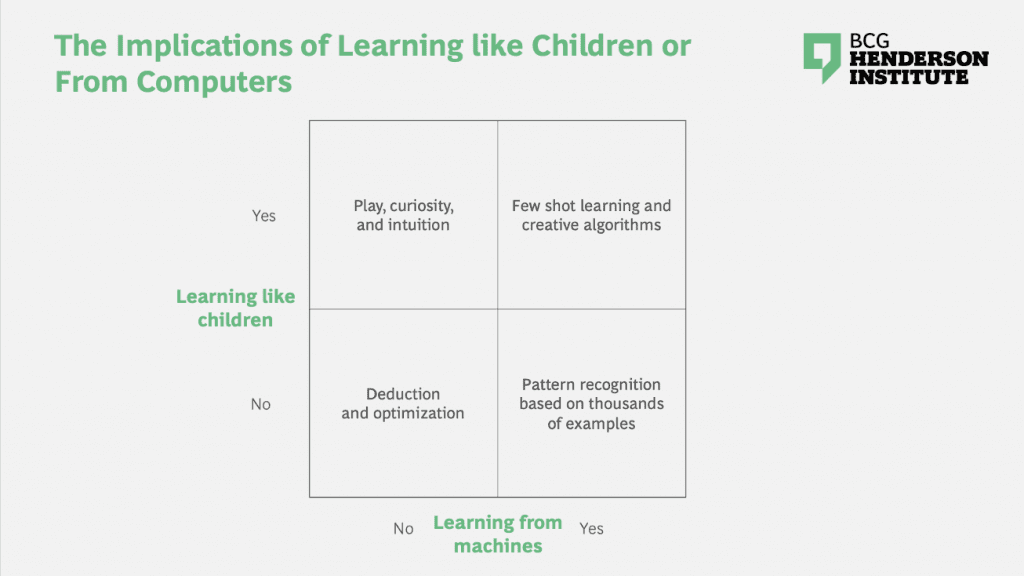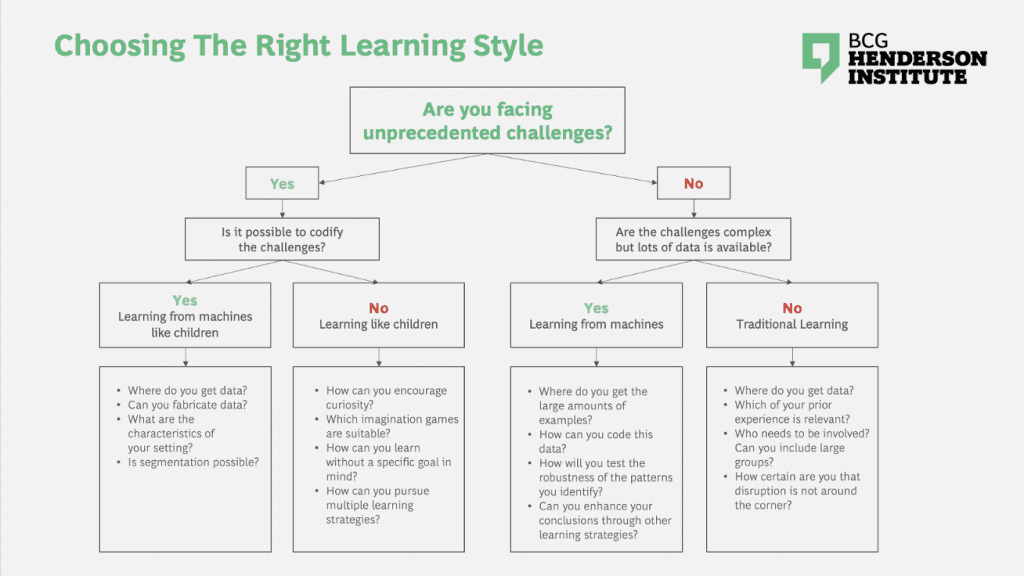Learning in a Dynamic Environment
In today’s dynamic world, competitive advantage must be constantly renewed. Digital technology allows business models to be rapidly copied and scaled, which requires that business models constantly evolve to stay ahead of competition. Companies, therefore, must compete on their ability to learn new things and to deploy dynamic solutions in a dynamic world.
But the learning strategies of many companies still reflect a bygone world in which competitive advantage was built on incremental optimization of an unchanging business model. As the importance of static efficiency wanes, this learning approach rooted in deduction and optimization no longer spells victory.
This then raises the question, what new learning mechanisms must companies use to compete effectively today?
We can extract valuable organizational lessons from two very different fields which also focus on learning: artificial intelligence and child development. Each offers new insights on its own, and together, they hint at new avenues for learning (see Figure 1).

Learning from machines
Many companies are now engaged in harnessing the power of AI. Spurred by the expansion of cheap computing power and the availability of large data sets, the technology has developed rapidly in recent years. The dominant form of artificial intelligence today is machine learning based on gradient descent. In many cases, it outperforms human experts in the detection of complex patterns. Amazon, for example, uses the vast amount of data it collects about your past purchasing behavior to predict your future purchasing. While the company has long used its algorithms to make purchasing recommendations, Amazon is now considering the next step: shipping goods before you even think about purchasing them.
Such approaches use large amounts of past data to predict future events. Machines are much more effective in processing large amounts of data to identify patterns, potentially positioning them to substitute some areas of human judgement in the future. At the same time, this also represents a critical limitation, as gradient descent algorithms require thousands of training examples to learn patterns. When the past is not representative of the future we’d like to predict or create, historic data sets can bias outcomes. When there are few precedents to use, the past will be a poor predictor of the future.
Learning like children
In contrast to computers, human infants have the ability to learn new things from very few examples.
Unlike most machine learning algorithms, children’s learning does not depend solely on correlation-based pattern recognition. Children develop an intuitive causal models, and use these to predict outcomes and take action.
In addition to using a different learning model from machines, humans have multiple styles of learning. They adapt these learning styles over time and apply them selectively to different situations. One way learning styles adapt is that they become less exploratory as humans mature from early life to adulthood. Why don’t organizations also cultivate and differentially apply multiple learning styles? For example, they could choose a more exploratory style in emerging spaces. Or they could create strategic ambidexterity, the ability to explore and exploit, by deploying more and less exploratory learning styles simultaneously in different situations.
Children also learn through play — a pleasurable, spontaneous form of learning involving imagination, in a context designed to minimize risk. Such playful exploration can be extremely productive for companies looking to reimagine and renew themselves. For example, the idea for Google Maps emerged from a meeting where Sergey Brin was distracted by browsable satellite images. Imagination games can be deployed to facilitate and guide such counter-factual exploration. For example, companies can view their business through the lens of maverick players on the edge of their industry, and by adopting this vantage point, discover new opportunities for self-disruption.
Relatedly, children’s learning is often driven by curiosity rather than specific goals. We can define curiosity in terms of being motivated by the possibility of improving one’s knowledge of the world, rather than of achieving a specific goal. When one does not know what one does not know, the orthodoxy of business goals can actually impede discovery and learning. Having no goal can be the best strategy in such situations!
Learning from machines like children
Organizations should resist the temptation to embrace machine learning only for pattern recognition and reasoning by correlation (so called abductive learning). Rather, they should develop causal insights and models by applying the approaches of child learning to carry out controlled experimentation and learn new things from very few examples (so called few shot learning (FSL)).
The developing field of few shot learning has demonstrated a number of ways in which learning can be accelerated without voluminous training data. FSL is particularly important in today’s unpredictable business environment, where unprecedented, non-repeating events like COVID or the Ukrainian war can unfold rapidly.
Broadly, there are 3 algorithmic strategies to realize FSL. One is to supplement training data in creative ways. Second is to reduce the search space of potential “solutions”. Third is to improve the algorithms so that the search for solutions is more targeted.
Training data can be supplemented with artificial data, created for example by flipping, rotating, cropping, or shearing image data. Applying the same principle, organizations can learn from physical or digital simulation what may be hard or impossible to learn from scarce real-life examples. In historically more stable business environments, we tend to emphasize “facts”, sometimes explicitly framing the objective of information systems as providing a “single source of truth”. But in a dynamic environment, it can be more relevant to compete on what could be the case, rather than what has been the case. The “facts” may either be sparce or unduly constrained by history.
But an unconstrained search space of future possibilities can be overwhelming. Techniques such as “generative modeling” can be used to constrain the search space. Using prior knowledge of related fields, we can frame and apply analogues that simplify the search for solutions. One of our fondest questions in strategy is “what is this an example of?”, which opens the door to leverage insights from related examples. For example, instead of looking for strategic learnings from the COVID pandemic, we can look at the broader class of economic and social shocks for lessons. By doing so, we are able, for example, to understand the factors which drive truly resilient companies to generate more value over time than merely efficient ones.
Algorithms can also be made more targeted in their search for solutions by using techniques like meta-learning — segmenting situations according to their characteristics. Good examples of this are the meta-strategies laid out in Your Strategy Needs a Strategy: by dividing competitive environments according to their degree of predictability, malleability and harshness, 5 different approaches to strategy (classical, adaptive, visionary, shaping and renewal) result, each associated with a unique approach to learning appropriate to that environment. For example, adaptive learning is focused on rapid cycles of experimentation, selection and amplification, and is suitable for fast evolving nascent spaces, whereas visionary learning is focused on slower cycles of observation, imagination and realization, and is more appropriate to newly created spaces.
Another related emerging field is the science of curious or creative algorithms. Here algorithms are designed to maximize productive surprise. These algorithms detect anomalies as opposed to established patterns, giving us the ability to learn new things about the world. In an organizational context, this could be deployed to spot emerging trends, or to first seek to explore and understand situations before constructing goals and plans.
In this way, extracting the algorithmic principles and strategies in the emerging field of FSL and deploying or translating these to the domain of organizational learning, can enable companies to improve their ability to learning new things that are hard to capture, rare or non-repeated.
The future of learning: create a portfolio of learning styles
Combining these insights from computer science and childhood development suggests new imperatives for building organizations which can compete on their ability to learn in dynamic and unpredictable competitive environments.
Most fundamentally, this means that we need to reconceive organizations as machines for competing on learning, rather than only on scale or efficiency. This has profound implications for what we measure and how we manage organizations. This will require organizations to expand their repertoire of learning models and then to identify the right learning style for each challenge at hand (see Figure 2).

Traditional learning:
The traditional analog ways of learning work best in situations where organizations can rely on similar experiences from the past, and humans are able to process the amount and complexity of data that needs to be considered. Here the main challenge is how an organization can gather the right type of data. Using crowdsourcing techniques that fold larger groups into the learning process is now feasible using digital tools and platforms. Telefonica, for example, does this using a company-wide forum where thousands of conversations take place every day. Companies should also cognitively partition work into the learning tasks best driven by humans from those best driven by machines — with humans more focused on tasks involving creativity, judgement, ethical reasoning or empathy.
Learning from Machines:
In cases where the human capacity is not sufficient to handle both the complexity and data that needs to be processed, machine learning comes into play. However, new obstacles can temper the power of machine learning. The rise of data protection laws will make the access to large amounts of examples less trivial, requiring companies to develop new processes for trust and consent. Also growing concerns around algorithmic bias, following instances such as Amazon’s algorithms excluding minority neighborhoods from Free Same-Day Delivery service, will require new techniques such as debiasing and data randomization.
Learning from machines like children:
New approaches can create insights into unprecedented situations when companies use AI techniques resembling the learning approaches taken by children. Therefore, when deploying AI in dynamic environments, do not restrict technologies to gradient descent models requiring voluminous training data. Rather, tap into the emerging science of FSL and curiosity driven models, which already have demonstrated applications in computer vision, robotics and other fields.
Learning like children:
When organizations face entirely unprecedented challenges, humans still have the upper hand. Small humans to be more precise. In experiments presenting kindergarteners and MBA students with the quest to build a tower out of spaghetti and marshmallows, the kids win hands down. Every time! MBA students find it difficult to experiment without careful planning. So the challenge will be to stimulate human curiosity through using imagination games and establishing a culture of imagination.
Organizations need to be choiceful and deliberate about applying the right learning style in each situation. Companies must develop a learning styles portfolio to pull from and develop learning ambidexterity to switch between styles in different scenarios — using play to foster the exploratory, imaginative learning styles for dynamic situations, and machine learning or traditional learning styles for those with greater precedent. And doing so will require organizations to design for synergy between machine and human learning by creating new hybrid learning architectures, combined with algorithmic governance, and algorithmic ethics.



